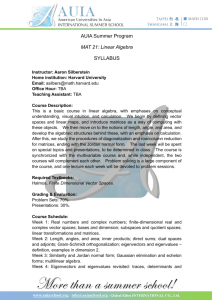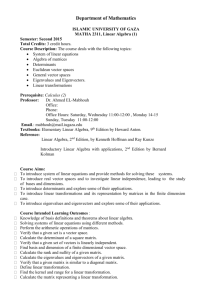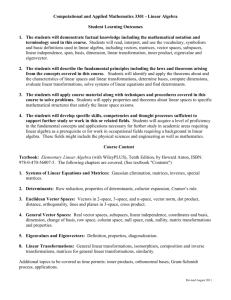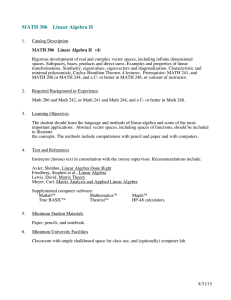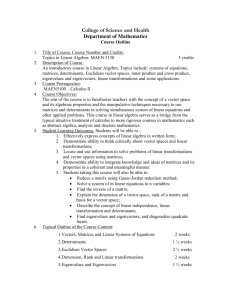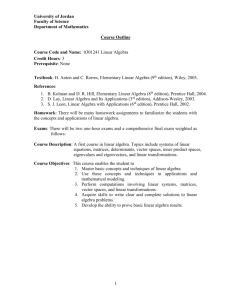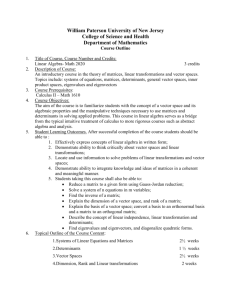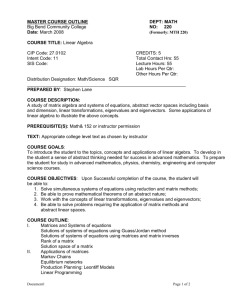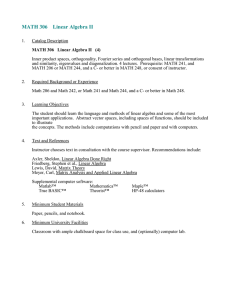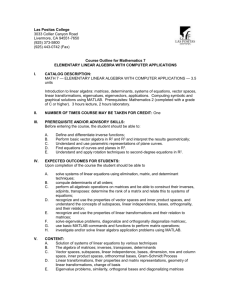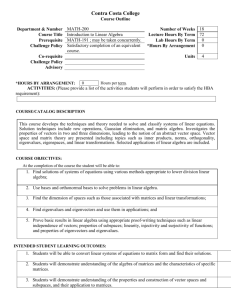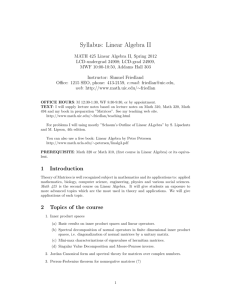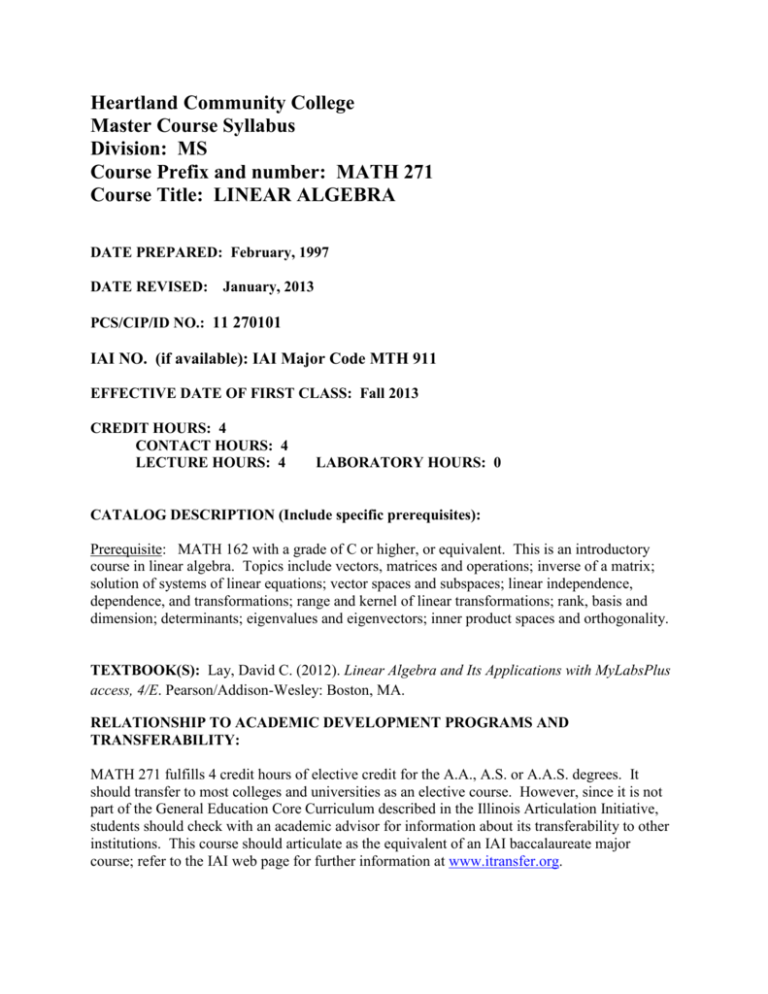
Heartland Community College
Master Course Syllabus
Division: MS
Course Prefix and number: MATH 271
Course Title: LINEAR ALGEBRA
DATE PREPARED: February, 1997
DATE REVISED: January, 2013
PCS/CIP/ID NO.: 11 270101
IAI NO. (if available): IAI Major Code MTH 911
EFFECTIVE DATE OF FIRST CLASS: Fall 2013
CREDIT HOURS: 4
CONTACT HOURS: 4
LECTURE HOURS: 4
LABORATORY HOURS: 0
CATALOG DESCRIPTION (Include specific prerequisites):
Prerequisite: MATH 162 with a grade of C or higher, or equivalent. This is an introductory
course in linear algebra. Topics include vectors, matrices and operations; inverse of a matrix;
solution of systems of linear equations; vector spaces and subspaces; linear independence,
dependence, and transformations; range and kernel of linear transformations; rank, basis and
dimension; determinants; eigenvalues and eigenvectors; inner product spaces and orthogonality.
TEXTBOOK(S): Lay, David C. (2012). Linear Algebra and Its Applications with MyLabsPlus
access, 4/E. Pearson/Addison-Wesley: Boston, MA.
RELATIONSHIP TO ACADEMIC DEVELOPMENT PROGRAMS AND
TRANSFERABILITY:
MATH 271 fulfills 4 credit hours of elective credit for the A.A., A.S. or A.A.S. degrees. It
should transfer to most colleges and universities as an elective course. However, since it is not
part of the General Education Core Curriculum described in the Illinois Articulation Initiative,
students should check with an academic advisor for information about its transferability to other
institutions. This course should articulate as the equivalent of an IAI baccalaureate major
course; refer to the IAI web page for further information at www.itransfer.org.
COURSE OBJECTIVES (Learning Outcomes):
After completing the course, the student will be able to:
Course Outcomes
General
Education
Outcomes
PS 3
1. Present the basic concepts of linear algebra in a
way that provides both geometric insight and
computational experience.
2. Solve systems of linear equations by any of
PS 3
several techniques and interpret the results.
3. Examine the relationships between matrices and PS 2
vector spaces, especially regarding linear
transformations and eigenvalues.
4. Understand the proofs of such fundamental
CT 3
theorems as the invertible matrix theorem, the
unique representation theorem, and the diagonal
matrix representation.
5. Apply fundamental principles of linear algebra PS 4
to problems in engineering, computer science,
mathematics, physics, economics, and statistics.
6. Use appropriate technology to solve problems
PS 4
and applications in linear algebra and interpret
the results.
COURSE/LAB OUTLINE:
1.
2.
3.
4.
5.
6.
7.
8.
9.
10.
11.
12.
13.
Vectors
Operations on matrices
Solution of systems of linear equations
Rank of a matrix
Vector spaces and subspaces
Linear dependence and independence
Basis and dimension
Linear transformations
Sums, composites, inverses of linear transformations
Range and kernel of a linear transformation
Determinants
Eigenvalues and eigenvectors
Orthogonality; inner product spaces
Range of Assessment
Methods
Throughout the
semester, the following
assessment methods
will be used to measure
the course and Gen. Ed.
Learning outcomes:
Exams, Quizzes,
Homework, Projects
METHOD OF EVALUATION (Tests/Exams, Grading System):
Instructors may determine the most appropriate methods of evaluation for their course. These
methods of evaluation might include but are not limited to exams, homework, quizzes, and
projects.
90 – 100% A
80 – 89% B
70 – 79 % C
60 – 69% D
Below 60% F
REQUIRED WRITING AND READING:
An ability to write coherent mathematical statements in English is essential for all students of
Linear Algebra, not just those who may major in math. Required writing will be part of
assignments and tests. Students will be expected to explain how they found the solution,
describe the solution graphically and numerically, and interpret the answer in the context of the
problem. Conceptual exercises that require a short proof will be expected from every student.
Students must read the required chapters as covered in the class.

